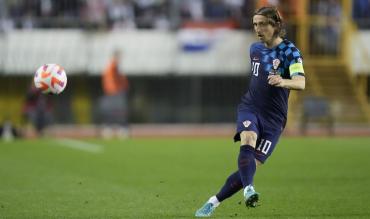Luka Modric is one of the most decorated players in modern times, a five-time winner of the Champions League with Real Madrid, not to mention the claiming of three La Liga titles.
Across a 13-year period, he is the only player to break up the Messi/Ronaldo duopoly for the Ballon d’Or award, in 2018 considered by his peers to be the best footballer on the planet.
He has illuminated a World Cup final and been awarded the Croatian Footballer of the Year merit on so many occasions the years blur together when reading them across a page.
But here, we focus mainly on his four seasons with Tottenham. A period when the Premier League boasted an astonishing talent but didn’t fully appreciate it at the time.
A period when Spurs possessed a generational great but didn’t really capitalise upon that fact.
That’s what you get when you partner a little genius with Wilson Palacios in midfield.
Modric arrived from Dinamo Zagreb in the summer of 2008 for a club record equalling sum of £16.5m and for a good while nobody knew what to make of him.
He looked too slight, flimsy. He looked like he could blow away in a breeze.
He also bore an unfortunate resemblance to Gail Platt from Coronation Street and though there was undoubtedly magic in his boots, and though he had a touch to die for, it seemed for a spell that the Zadar-born schemer would go the same way as many other continental craftsmen.
We would see glimpses of brilliance, amidst all the hurly-burly of a typically tough fixture, played at a typically tough ground, in proverbial weather on a Wednesday night.
But elsewhere he would be pushed to the margins. Made anonymous, even ineffective. Outmuscled by the frenetic environs of the English top-flight.
Enter Harry Redknapp that autumn, who initially needed some convincing on taking stock of his midfield options – resplendent with Zakoras and Huddlestones and, yes, Palacios – and recognising Tottenham’s predicament, marooned as they were in the bottom three.
What he needed was passion and energy and drive. Could a diminutive maestro survive in such a centre-circle, never mind thrive?
Seeing Modric train with a daily intensity however persuaded Redknapp to instal him centrally and the rest, as they say, is history.
In due course, Spurs corrected their betting odds that priced them to struggle and Modric was at the heart of their recovery, lifting them to eighth that season before orchestrating three consecutive top four-chasing campaigns, the club successful in securing Champions League football twice-over.
And what we essentially witnessed over these years was the same artistry and exquisite manoeuvring of team-mates that’s been drooled over at the Bernabeu, only alongside inferior fare.
Because, granted, Tottenham had Bale and Van der Vaart. They had Jermain Defoe, who could alter the football betting via a single spin inside the box. But they also had Alan Hutton.
In that regard, Modric was a rare, sparkling jewel set in a necklace purchased from Argos.
We were so incredibly lucky to have him, for those brief few seasons. We just didn’t know it at the time.
*Credit for all of the photos in this article belongs to AP Photo*


